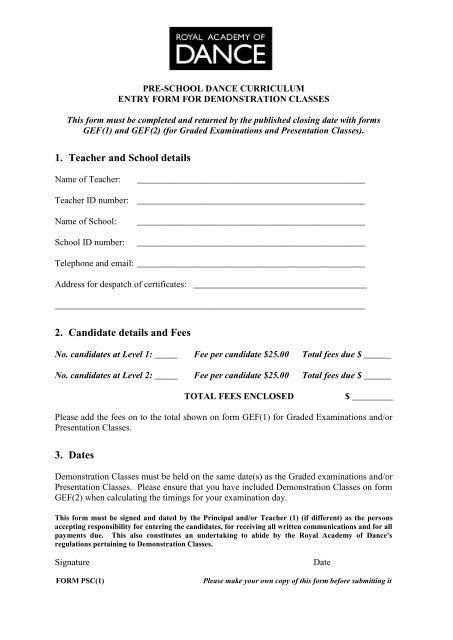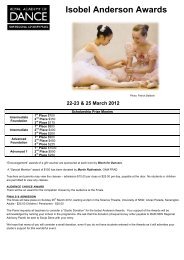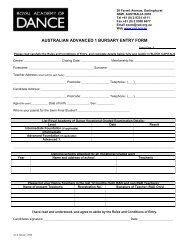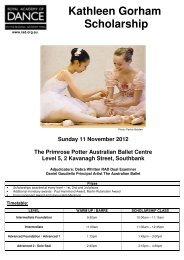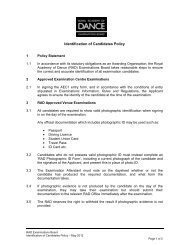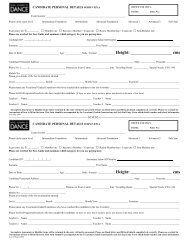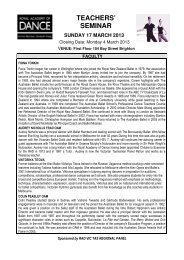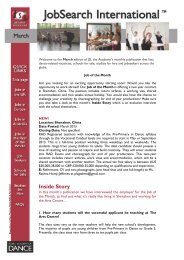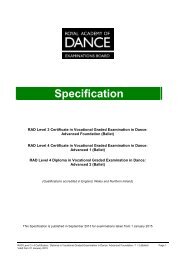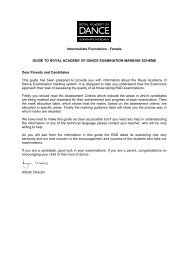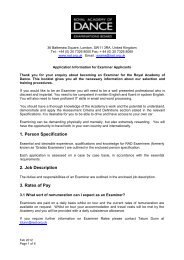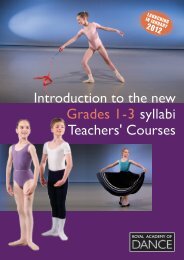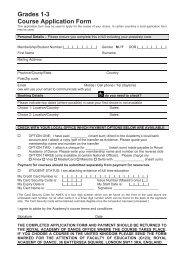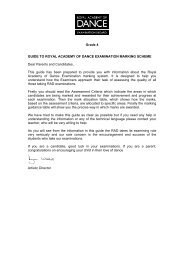Demonstration Class PSC 1 & PSC 2 - Royal Academy of Dance
Demonstration Class PSC 1 & PSC 2 - Royal Academy of Dance
Demonstration Class PSC 1 & PSC 2 - Royal Academy of Dance
Create successful ePaper yourself
Turn your PDF publications into a flip-book with our unique Google optimized e-Paper software.
PRE-SCHOOL DANCE CURRICULUMENTRY FORM FOR DEMONSTRATION CLASSESThis form must be completed and returned by the published closing date with formsGEF(1) and GEF(2) (for Graded Examinations and Presentation <strong>Class</strong>es).1. Teacher and School detailsName <strong>of</strong> Teacher:__________________________________________________Teacher ID number: __________________________________________________Name <strong>of</strong> School:School ID number:____________________________________________________________________________________________________Telephone and email: __________________________________________________Address for despatch <strong>of</strong> certificates: __________________________________________________________________________________________________________2. Candidate details and FeesNo. candidates at Level 1: _____ Fee per candidate $25.00 Total fees due $ ______No. candidates at Level 2: _____ Fee per candidate $25.00 Total fees due $ ______TOTAL FEES ENCLOSED$ _________Please add the fees on to the total shown on form GEF(1) for Graded Examinations and/orPresentation <strong>Class</strong>es.3. Dates<strong>Demonstration</strong> <strong>Class</strong>es must be held on the same date(s) as the Graded examinations and/orPresentation <strong>Class</strong>es. Please ensure that you have included <strong>Demonstration</strong> <strong>Class</strong>es on formGEF(2) when calculating the timings for your examination day.This form must be signed and dated by the Principal and/or Teacher (1) (if different) as the personsaccepting responsibility for entering the candidates, for receiving all written communications and for allpayments due. This also constitutes an undertaking to abide by the <strong>Royal</strong> <strong>Academy</strong> <strong>of</strong> <strong>Dance</strong>'sregulations pertaining to <strong>Demonstration</strong> <strong>Class</strong>es.SignatureFORM <strong>PSC</strong>(1)DatePlease make your own copy <strong>of</strong> this form before submitting it
PRE-SCHOOL DANCE CURRICULUMDEMONSTRATION CLASSES1 What are <strong>Demonstration</strong> <strong>Class</strong>es?<strong>Demonstration</strong> <strong>Class</strong>es are an optional part <strong>of</strong> the Pre-School <strong>Dance</strong> Curriculum; they allow thechildren an opportunity to perform a selection <strong>of</strong> the material covered over the year to an invitedaudience <strong>of</strong> parents/carers <strong>of</strong> those participating and an Examiner. An Examiner <strong>of</strong> the <strong>Royal</strong><strong>Academy</strong> <strong>of</strong> <strong>Dance</strong> will be present not to assess the children but to watch and enjoy the children’sdemonstration, adding to the sense <strong>of</strong> occasion. <strong>Demonstration</strong> <strong>Class</strong>es are held at Level 1 (targetage range 2½ - 3½) and Level 2 (target age range 3½ - 4½/5). Although recommended age rangesare given, neither an upper nor a lower age limit will be enforced.2 What should the content <strong>of</strong> a <strong>Demonstration</strong> <strong>Class</strong> be?Teachers should plan the class so that, using the chosen theme, the content addresses the fourlearning outcomes <strong>of</strong> the Curriculum. Teachers should be selective in their choice, meeting theneeds <strong>of</strong> their children. Each class will be ‘unique’ in that the content will be derived from theteacher and children’s own inspirations. The teacher conducts and participates in the class as usual,in the children’s regular class environment. Teachers can decide to use a pianist or recorded music.Recorded music can be chosen from the CD supplied with the resource pack, or can be the teacher’sown choice. Resources (e.g. dressing up clothes and props) can be used if so desired.3 How can children be entered for <strong>Demonstration</strong> <strong>Class</strong>es?Anyone purchasing the resource pack can teach the Pre-School <strong>Dance</strong> Curriculum, but only thosewho hold RAD Registered Teacher Status can enter children for <strong>Demonstration</strong> <strong>Class</strong>es, althoughthey may engage the help <strong>of</strong> an assistant in preparing the children. <strong>Demonstration</strong> <strong>Class</strong>es are heldonly during the course <strong>of</strong> a normal Graded examination session, and teachers wishing to enterchildren must also have examination and/or Presentation <strong>Class</strong> entries in the same session.<strong>Demonstration</strong> <strong>Class</strong>es cannot be used to make up the 3-hour minimum for Graded examinationsand Presentation <strong>Class</strong>es.4 Is there a separate entry form?Yes. Form <strong>PSC</strong>(1) can be obtained from Regional Administrators in the UK or NationalAdministrators in other countries. It must be completed and returned at the same time as formsGEF(1) and GEF(2) (i.e. when the entry is made for Graded Examinations and/or Presentation<strong>Class</strong>es). The <strong>Demonstration</strong> <strong>Class</strong> can take place at any point during the examination day, but if anaudience is to be invited it is probably best to place it either at the start or the end <strong>of</strong> the day. Onform GEF(2) teachers should write <strong>PSC</strong> L1 or <strong>PSC</strong> L2 as appropriate in the Level column, with thetimings, but it is not necessary to list the names <strong>of</strong> the children, nor is it necessary for these childrento be registered in advance on the <strong>Academy</strong>’s database.5 How many children can participate in the class?In order to give children the maximum benefit from the experience, it is recommended that numbersdo not exceed 16 per class. The teacher/pupil ratio for the age group should be consistent with thelegislation <strong>of</strong> the country <strong>of</strong> residence, and teachers may therefore be required to have one or moreassistants with them while the <strong>Demonstration</strong> <strong>Class</strong> takes place. It is entirely the responsibility <strong>of</strong>the teacher to ensure that any such legislation relating to working with very young children iscomplied with. It is essential that the person with Registered Teacher Status is the person primarilyresponsible for conducting the class.
6 How long is the class?This depends on the number <strong>of</strong> children involved. 30 minutes should be allowed for up to 8children; for 9-16 children, 45 minutes will be needed.7 What are the entry fees?Information about fees will normally be published in the Diary in Australia. Payment <strong>of</strong> fees mustbe added onto the total shown on form GEF(1) for Graded Examinations and/or Presentation<strong>Class</strong>es. No refunds will be given for children who are entered for a <strong>Demonstration</strong> <strong>Class</strong> but on theactual day do not participate; if these children have been regularly attending classes with the teacher,they will still receive a certificate listing their achievements.8 Do the children receive any kind <strong>of</strong> recognition or feedback?Yes. All participating children will receive a certificate <strong>of</strong> achievement for the level undertaken,which will normally be presented by the Examiner <strong>of</strong> the <strong>Royal</strong> <strong>Academy</strong> <strong>of</strong> <strong>Dance</strong> at the end <strong>of</strong> theclass (although this may be done by the teacher on another occasion if s/he prefers). Certificates <strong>of</strong>achievement will mark the child’s participation and involvement in the Pre-School <strong>Dance</strong>Curriculum for the appropriate level. The certificates will be sent in advance to the teacher, so thats/he can complete a tick-box evaluation on the reverse side before the certificates are presented, toinform parents/carers <strong>of</strong> the child’s progress.9 What happens on the day <strong>of</strong> the <strong>Demonstration</strong> <strong>Class</strong>?The class will take place alongside the Examinations and Presentation <strong>Class</strong>es scheduled for theschool. The audience should be seated where the teacher and children feel most comfortable. Thenumber <strong>of</strong> people in the audience should comply with the health and safety requirements applicableto the building in which the class is to be conducted. Members <strong>of</strong> the audience must comply withthe following conditions (and should be alerted to them in writing in advance by the teacher):No children under 12 years <strong>of</strong> age may be admitted as guestsNo photography or video recording is allowedNo food or drink is allowed in the studioNo smoking is allowed in the studioGuests must not attempt to speak to or otherwise distract their childGuests must remain silent during the <strong>Demonstration</strong> <strong>Class</strong>Mobile phones must be switched <strong>of</strong>fNo opportunity will be given for guests to discuss the class with the ExaminerGuests will not be admitted once the class has startedGuests must enter and leave the studio quickly so as not to disrupt the examination timetableand may not leave until the end <strong>of</strong> the <strong>Demonstration</strong> <strong>Class</strong>No fees may be charged by the teacher for observing the <strong>Demonstration</strong> <strong>Class</strong>If the Examiner is to present the certificates to the children, the teacher should hand them over,ready completed, before the start <strong>of</strong> the class. The Examiner will ring the bell when she is ready tobegin, and the teacher (and any assistants) should then lead the children into the studio. No uniformis prescribed, and there is no need for the children to wear colours or numbers. The teacher shouldvery briefly introduce the children to the examiner and then proceed to conduct the class. At the end<strong>of</strong> the class the Examiner will normally present the certificates to the children.Issued: November 2003


